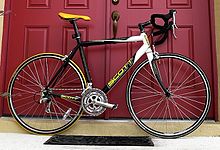
Back Гоначны веласіпед Byelorussian Silniční kolo Czech Rennrad German Vetkura biciklo Esperanto Maantiepyörä Finnish Vélo de route French Racefyts Frisian Bicicleta de estrada Galician אופני כביש HE Országúti kerékpár Hungarian



A racing bicycle, also known as a road bike is a bicycle designed for competitive road cycling, a sport governed by and according to the rules of the Union Cycliste Internationale (UCI).
Racing bicycles are designed for maximum performance while remaining legal under the UCI rules. They are designed to minimise aerodynamic drag, rolling resistance, and weight, and balance the desire for stiffness for pedaling effiency with the need for some flexibility for comfort. Racing bicycles sacrifice comfort for speed compared to non-racing bicycles. The drop handlebars are positioned lower than the saddle to put the rider in a more aerodynamic posture. The front and back wheels are close together so the bicycle has quick handling, which is preferred by experienced racing cyclists. The derailleur gear ratios are closely spaced so that the rider can pedal at their optimum cadence. However, racing bicycles must retain the ability to maneuver safely within a tightly-packed peloton, and be sufficiently comfortable to ride for races of six hours or more.
Bicycles and most wheels ridden in professional competition must be type-approved by the UCI,[1] and made available for commercial sale.[2] It is common for professional road cycling teams to use prototype bicycles and equipment before they become commercially available.
Racing bicycles are generally legal for use on public roads and are widely used for non-racing fitness and utility riding.
- ^ "List of Approved Models of Framesets" (PDF). UCI.ch. Union Cycliste Internationale. Retrieved 21 February 2022.
- ^ Fretz, Caley (28 December 2011). "The Torqued Wrench: Good ideas gone awry". VeloNews. Outside Media. Retrieved 9 March 2022.
© MMXXIII Rich X Search. We shall prevail. All rights reserved. Rich X Search